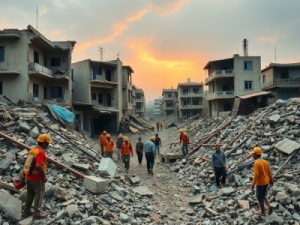Aftershocks Rattle Malibu: A Look at the Recent Earthquake and Its Impact

Aftershocks Rattle Malibu: A Look at the Recent Earthquake and Its Impact
Malibu, California, was shaken early this week by a magnitude-4.7 earthquake, a tremor strong enough to be felt across much of the Los Angeles region. The quake, which struck just off the coast, has been followed by dozens of aftershocks, raising concerns among residents and seismologists alike.
The Initial Earthquake: What Happened?
The magnitude-4.7 quake hit at approximately 3:30 a.m. local time, waking many Malibu residents from their sleep. The epicenter was located roughly 10 miles off the coast of Malibu at a depth of 6 miles. While the quake did not cause significant damage, it was strong enough to be felt across the Westside, from Santa Monica to parts of the San Fernando Valley.
Local authorities reported no immediate injuries or major structural damage. However, the event served as a wake-up call for those living in the earthquake-prone region. Southern California sits on several active fault lines, including the notorious San Andreas Fault, which makes even small tremors a source of anxiety for many locals.
Aftershocks Add to the Tension
Since the main shock, more than 30 aftershocks have been recorded, ranging from magnitudes of 1.5 to 3.8. These smaller quakes have been unsettling for residents, many of whom are on edge, waiting to see if another, more significant quake might follow.
Experts from the U.S. Geological Survey (USGS) stress that aftershocks are a normal part of the process after an earthquake of this size. While they usually decrease in frequency and intensity over time, the risk of a larger aftershock remains for the first few days to weeks following the initial event.
Community Response and Preparedness
Malibu residents have responded with a mix of caution and resilience. Local businesses, schools, and homeowners have been double-checking their emergency plans, securing heavy furniture, and ensuring that disaster kits are up to date. Social media has been abuzz with residents sharing their experiences, safety tips, and even humor in the face of the uncertainty.
Local officials have reminded everyone of the importance of being prepared, emphasizing that earthquakes can strike without warning. The City of Malibu, alongside various community organizations, has offered resources on earthquake readiness, including guides on how to “Drop, Cover, and Hold On” during a quake and what to do in the aftermath.
Why Earthquakes Happen in Southern California
Earthquakes are common in Southern California due to the region’s unique geological features. The state’s complex system of fault lines, including the San Andreas Fault, is constantly shifting. When pressure builds up along these faults and is released suddenly, an earthquake occurs.
The fault lines near Malibu, while less famous than the San Andreas, are still quite active. Seismologists say that this recent earthquake is a reminder of the continuous tectonic activity beneath our feet. They also stress that while technology has advanced in predicting potential hazards, no one can predict exactly when or where the next big one will hit.
What’s Next for Malibu?
In the days following the quake, Malibu remains on alert. The local government has urged residents to stay informed, be prepared, and not to panic. City officials are conducting inspections of critical infrastructure, such as bridges and roads, to ensure their safety.
Seismologists will continue to monitor aftershocks and gather data to better understand the fault lines in the area. The recent activity may also spur discussions on building codes, emergency response plans, and community education about earthquake safety.
How to Stay Prepared
For those living in earthquake-prone areas like Malibu, preparedness is key. Having a plan in place, knowing where to take shelter, and keeping an emergency kit with essentials such as water, non-perishable food, a flashlight, and a first aid kit can make a huge difference in the event of a more significant earthquake.
While it’s impossible to predict when the next earthquake will strike, being ready can help reduce the fear and uncertainty that comes with living in a seismic hotspot. In the meantime, life in Malibu continues, with residents hoping for calm and preparing for whatever might come next.
The recent earthquake and its aftershocks are a stark reminder of the geological realities of living in Southern California. While this event did not result in widespread damage, it has reignited conversations about safety, preparedness, and community resilience. As Malibu and its residents navigate the aftermath, they do so with a mix of caution and confidence, knowing that preparedness is their best defense against nature’s unpredictability.
Remember, it’s always better to be prepared than to be caught off guard. If you live in an earthquake-prone area, take the time now to make sure you and your loved ones are ready.





